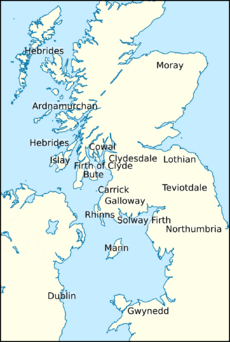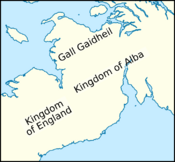Suibne mac Cináeda facts for kids
Quick facts for kids Suibne mac Cináeda |
|
|---|---|
| King of the Gall Gaidheil | |

Suibne's name as it appears on folio 16v of Oxford Bodleian Library MS Rawlinson B 488 (the Annals of Tigernach): "Suibne mac Cinaetha".
|
|
| Died | 1034 |
| House | possibly the Alpínid dynasty |
| Father | possibly Cináed mac Maíl Choluim or Cináed mac Duib |
Suibne mac Cináeda (died 1034) was a ruler from the 11th century. He was a leader of the Gall Gaidheil, a group of people who had both Viking (Scandinavian) and Gaelic backgrounds. We don't know much about Suibne. His name only appears in three old records that mention when he died.
Suibne likely ruled in an area where the Gall Gaidheil lived. This could have been the Hebrides islands, the Firth of Clyde region, or along the southwest coast of Scotland, stretching into Galloway. His last name, "mac Cináeda," means "son of Cináed." This might mean he was part of the royal Alpínid dynasty of Scotland. For example, he could have been a brother of Máel Coluim mac Cináeda, King of Alba, who was the king at the time. Or, he might have been a son of Cináed mac Duib, King of Alba.
Suibne's time as a ruler seems to have happened when the Gall Gaidheil were expanding their power. This expansion was along the southwest coast of what is now Scotland. This growth may have helped lead to the end of the Kingdom of Strathclyde. Strathclyde was a kingdom that was already facing attacks from Vikings from Dublin, people from Northumbria, and the Scots. We don't know how Suibne died. One idea is that he was caught up in the struggles for power within the Alpínid royal family.
Who Was Suibne mac Cináeda?
Suibne's death in 1034 is mentioned in three historical books: the Annals of Ulster, the Annals of Tigernach, and the Annals of Loch Cé. These books call him "ri Gall-Gaidhel" or "King of the Gall Gaidheil." This title suggests he ruled in the Isles, Galloway, or somewhere along the southwest coast of Scotland. We know very little else about Suibne, as he isn't mentioned in any other historical records.
The word Gaidheal means a person who speaks Gaelic. The term Gall Gaidheil means "Stranger-Gaidheil." It first appeared in records in the mid-9th century. At that time, "Gall" meant Scandinavians (Vikings). So, Gall Gaidheil likely meant "Scandinavian-Gaidheil" or "Viking-Gaels." This term was used for people in the Hebrides and parts of the old kingdom of Dál Riata who had mixed Viking and Gaelic backgrounds. A leader of the Gall Gaidheil in the mid-9th century was Caittil Find. He might be the same person as Ketill Flatnefr from Viking stories. If Caittil was a Hebridean chief, it could mean Suibne was also a chief from the Hebrides.

The Scottish place name Galloway comes from the Gaelic phrase "i nGall Gaidhealaib," which means "amongst the Gall Gaidheil." An old Norse book from the 13th century, the Orkneyinga saga, calls Galloway "Gaddgeðlar." This name clearly comes from Gall Gaidheil. The Galloway region was definitely linked to the Gall Gaidheil even earlier. Two rulers from Galloway, Roland fitz Uhtred and Alan fitz Roland, were also called "King of the Gall Gaidheil" in the Annals of Ulster, just like Suibne.
Even though Suibne had the same title, there's no proof he was related to these later rulers of Galloway. It wasn't until the 12th century that the term Gall Gaidheil became mainly used to describe the people within the borders of Galloway.
Suibne's Time and Connections

If Suibne ruled in Galloway, his death records might be the first time the term Gall Gaidheil was used for that area. This would also make him an early ruler of Galloway. Another important person around Suibne's time was Echmarcach mac Ragnaill, King of Dublin and the Isles. He might have also ruled in Galloway. Around 1031, Echmarcach met with Knútr Sveinnsson, King of England, who ruled England, Denmark, and Norway. If Suibne and Echmarcach both had ties to Galloway, their dealings with the English king could mean they were rivals in the region.
The original homeland of the Gall Gaidheil on the mainland seems to have been larger than just Galloway. Old texts from the 9th century show that the Isle of Bute, an island in the Firth of Clyde, was part of the Gall Gaidheil territory. This suggests their original lands might have been in the Firth of Clyde area and nearby Cowal. Later, the region known as the Rhinns also included what is now the Machars. This whole area would have stretched from the North Channel to Wigtown Bay, covering a region similar to modern Wigtownshire.

Another person who might have held power in Galloway around Suibne's time was Amlaíb, a son of Sitriuc mac Amlaíb, King of Dublin. According to a 13th-century book, Historia Gruffud vab Kenan, Amlaíb was the grandfather of Gruffudd ap Cynan, King of Gwynedd. This book says Amlaíb held royal power in the Rhinns and the lands of the Gall Gaidheil, treating them as separate areas. This suggests that the region of modern Wigtownshire was seen as different from the Gall Gaidheil territory in the 11th century. This account might also mean Amlaíb lived at the same time as Echmarcach and Suibne. It could mean he ruled in Galloway and the Isles sometime between 1028 and 1034.
| Simplified family tree of the Alpínid dynasty, the ruling family of Alba (Scotland). Either of the two highlighted men could have been Suibne's father. | |||||||||||||||||||||||||||||||||||||||||||||||||||||||||||||||||||||||||||||||||||||||||||||
|---|---|---|---|---|---|---|---|---|---|---|---|---|---|---|---|---|---|---|---|---|---|---|---|---|---|---|---|---|---|---|---|---|---|---|---|---|---|---|---|---|---|---|---|---|---|---|---|---|---|---|---|---|---|---|---|---|---|---|---|---|---|---|---|---|---|---|---|---|---|---|---|---|---|---|---|---|---|---|---|---|---|---|---|---|---|---|---|---|---|---|---|---|---|
|
|||||||||||||||||||||||||||||||||||||||||||||||||||||||||||||||||||||||||||||||||||||||||||||
Suibne's last name is the same as that of the reigning Scottish king, Máel Coluim mac Cináeda, King of Alba. This could mean they were related. One idea is that Suibne and Máel Coluim were brothers. If so, Máel Coluim might have placed Suibne on the throne in the Gall Gaidheil region. This idea is supported by an old text, the Prophecy of Berchán, which links Máel Coluim with Islay and Arran. Also, a writer named Ailred claimed that people from Galloway were under the rule of Máel Coluim's later successor.
Máel Coluim certainly expanded Scottish royal power south into Lothian and Strathclyde. If he put his brother in charge of Galloway, it would suggest he also had power there. This might have happened after he took over the former kingdom of Strathclyde. The records of Suibne's death could be the first sign of Scottish control in regions southwest of the River Clyde. If Suibne and Máel Coluim were not brothers, Suibne's last name could mean he was a son of Cináed mac Duib, King of Alba. This might mean Máel Coluim allowed Suibne to rule the Gall Gaidheil to keep him from trying to become King of Alba.
It's possible that the decline of the Cumbrian kingdom of Strathclyde in the 11th century was linked to the expansion of the Gall Gaidheil. One of the last known rulers of Strathclyde was Owain Foel, King of Strathclyde. He helped Máel Coluim fight against the Northumbrians in 1018. It's possible that the Gall Gaidheil started moving into Cumbrian lands after Owain Foel died. Máel Coluim might have also taken advantage of Owain's death to claim the Cumbrian kingship for himself.
One idea is that Suibne, as King of the Gall Gaidheil, was directly involved in conquering the western coastal areas of the Cumbrians. The Annals of Tigernach mention an attack on Britons in 1030 by Vikings from Dublin and the English. Since English and Welsh records don't mention this attack, it might refer to the Cumbrians rather than the Welsh. The claim from Historia Gruffud vab Kenan—that Sitriuc's son ruled in the Rhinns and other areas—could further suggest that the Cumbrians were attacked by people from Dublin. These attacks might have been coordinated with the Gall Gaidheil.

Another possibility, if Suibne and Máel Coluim were brothers, is that Suibne's title means Máel Coluim took over the empty Cumbrian kingship and made Suibne king over the Cumbrians. This might explain why the Scots didn't immediately use their victory over the Northumbrians. Instead, Máel Coluim's efforts might have been focused on the vulnerable Cumbrian kingdom.
Echmarcach's meeting with Knútr included two other kings: Máel Coluim and the ruler of Moray, Mac Bethad mac Findlaích. Máel Coluim and Mac Bethad seem to have been related, but the relationship between Máel Coluim and Echmarcach is unclear. If Suibne was Máel Coluim's brother and ruled Galloway for him, it could mean Echmarcach was also a king who served Máel Coluim. The agreement with Knútr might suggest that Máel Coluim had power over both Mac Bethad and Echmarcach. If so, and if Máel Coluim truly held power in the southern Hebrides, Echmarcach's kingdom might have included Mann, the Rhinns, and only the Hebridean islands north of the Ardnamurchan peninsula. If Suibne and Máel Coluim were brothers, it's even possible that the Scots drove Echmarcach out of the Isles sometime between the agreement with Knútr and Suibne's death.

Another idea, if Máel Coluim and Suibne were related, is about their deaths. Both men died in the same year. Máel Coluim was the last member of the Alpínid dynasty to rule the Kingdom of Scotland. He was followed by his grandson. Later in his rule, Máel Coluim seemed to try to remove possible threats to the royal family. In 1033, he might have arranged the killing of a son or grandson of a man named Boite mac Cináeda. We don't know exactly who Boite was—he could have been Máel Coluim's brother or cousin. Máel Coluim himself died under unclear circumstances.
If Máel Coluim and Suibne were brothers, their deaths in the same year could be linked. This might suggest a conflict between the kings, with Suibne possibly dying in battle against Máel Coluim. If Suibne was a son of Cináed mac Duib, Máel Coluim's efforts to remove rivals might show that Máel Coluim and Suibne had an agreement about the kingship. In any case, if Suibne had no family ties to the later rulers of Galloway, it's possible that his kingdom ended with him.




